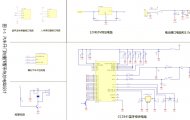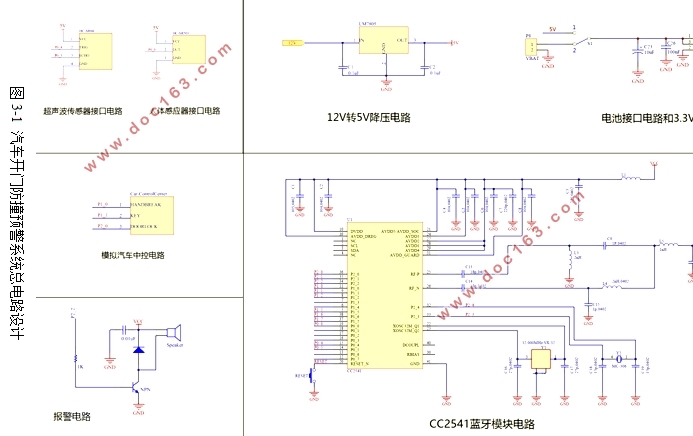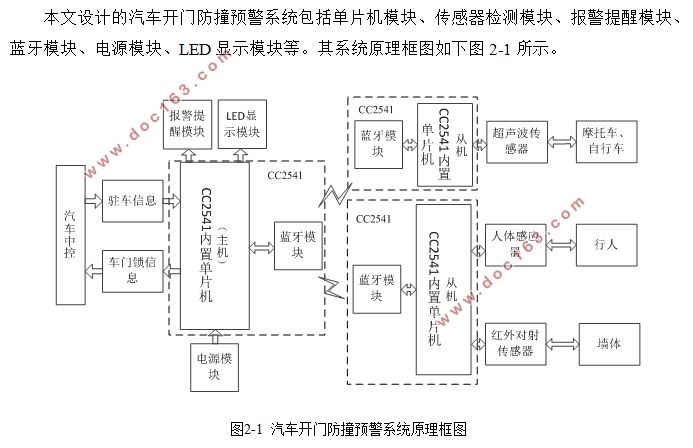基于蓝牙技术的汽车开门防撞预警系统设计

基于蓝牙技术的汽车开门防撞预警系统设计(论文15400字)
摘要:针对驾驶员驻车时由于车门开启不当造成同向行驶的非机动车、行人撞上车门或者车门蹭到墙,且现有汽车防撞类系统布线复杂、安装时对车身损害较大等问题,本论文设计了一种基于蓝牙技术的汽车开门防撞预警系统,该系统采用蓝牙4.0BLE技术对现有防撞系统进行无线化改造,利用超声波传感器、红外对射传感器以及热释电传感器构成防撞信息检测系统,并通过蓝牙将防撞信息无线传输给主控芯片,避免了车内的长距离布线,简化了安装。本设计采用高性能、低功耗的CC2541片载系统作为数据处理的核心,结合传感器测距模块、蓝牙收发模块、报警提示模块、电源模块等模块设计出了一种新型汽车开门防撞预警系统。
关键词:汽车;防撞;蓝牙;超声波;红外
The design of Automotive Door Opening Collision Avoidance System based on BLE
Abstract: It is a common phenomenon that non-motor vehicles and pedestrians in the car driving direction hit the door or the door scratches wall, which results from the drivers' opening the doors improperly. Nevertheless, the existing automotive anti-collision system is complex in wiring and harmful to the car in installation. To solve this problem, the design employs Bluetooth 4.0 wireless technology to transform the existing anti-collision system, using ultrasonic sensors, infrared correlation of sensor and pyro electric sensor as the anti-collision information detection system, and the anti-collision information via Bluetooth wireless transmission as the main control chip. This design avoids the long distance wiring inside the car and simplifies the installation. This design adopts the high performance and low power consumption CC2541 SoC as the core of the automotive door opening collision avoidance system, combined with the distance measuring sensor module, bluetooth transceiver module, alarm module, power module and other modules, finally forms a new type of system.
Key words: Car; Collision avoidance; Bluetooth; ultrasonic; infrared


目 录
1 引言 1
1.1 研究意义 1
1.2 研究现状 2
1.3 本文工作内容 3
2 设计方案论证 4
2.1 本设计目的 4
2.2 本设计的技术方案 5
2.2.1 单片机主控芯片的选择 6
2.2.2 开门风险监控模块设计 6
2.2.3 蓝牙模块设计 7
2.2.4 报警提醒模块设计 7
[来源:http://Doc163.com]
2.2.5 LED显示模块模块设计 7
2.2.6 电源模块设计 8
2.3 本设计所带来的有益的优点和效果 8
3 系统硬件设计与实现 8
3.1 系统硬件概述 8
3.2 主要单元电路设计 10
3.2.1 电源电路 10
3.2.2 传感器模块电路 10
3.2.3 蓝牙模块电路 12
3.2.4 LED显示模块设计 13
3.2.5 报警电路 13
3.2.6 汽车中控信息交换电路 14
4 程序设计 14
4.1 基于蓝牙技术的汽车开门防撞预警系统的主程序设计 14
4.2 子程序设计 16
4.2.1 超声波传感器HC-SR04程序 16
4.2.2 红外人体感应器HC-SR501和红外对射传感器程序 17
5 系统调试 18 [资料来源:http://doc163.com]
5.1 软件调试 18
5.2 硬件调试 18
6 结论 22
参考文献: 22
致谢 24
[资料来源:http://www.doc163.com]
